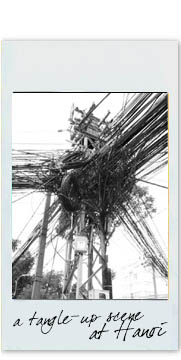公平?咖啡?
…… 家中男人繼續用心地偷偷地寫,又給我強行刊登了。
話說在讀這篇文的時候,我又想起了那天在兩周一聚說「每人心中都有一間咖啡店」的話題。
___________________________
現在很多時買咖啡,都會見到一個”fair-trade”(公平咖啡)標籤。話說種稙咖啡豆的農民生活都很苦。原因之一是部分農民都在是在咖啡園幫園主打 工而園主只給可恥的工錢。另一原因是為咖啡豆的賣價都給大採購商壓得很低。所以很多年前便有一班熱心人組成了一個公平貿易組織。他們會為咖啡豆農組織合作 社,同時透過宣傳及遊說各大連鎖超市,用比市價較高的價錢向豆農購買咖啡豆,從而幫豆農改善生活。所有附合這個組織要求的咖啡都會有一個”fair- trade”標籤。當然這些咖啡都會賣得比較貴。由于改善人權在歐美是很有市場的,所以這些貴一點的咖啡的銷路是絕對沒有問題的。但究竟最後農民有幾多得 益呢?
.
根據自由市場理論,市場價都會反映實際市場供應。市價升人們便增加生產,反之亦然,直到市場達至平衡。但種咖啡樹是要3-5年才會有收成的。所以今天如果 需求增加以致市價大升令豆農一窩蜂大種咖啡樹的話。三幾年後新咖啡樹開始有收成的時候,市場價便會隨供應急增而大瀉。那麼農民的投資便血本無歸了。但有了 ”fair-trade”保証最低採購價每磅 USD1.26 後,農民便不會有市價比成本低而無飯吃的問題。同時,”fair-trade”的合作社亦會同時給農民開班教導有效的種稙法和提供市場資訊。合作社甚至給農民提供貸款,幫助農民購買新農具,提升農民生活質素。但這個看似美好的計劃有個漏洞,就是人的天性。
.
當保証價是USD1.26,參加了”fair-trade”的農民為了增加收入,便會生產最便宜,亦即很多時質量最差的咖啡豆。(非”fair- trade”的農民生產的咖啡豆賣價,是和質量及品種成正比的)所以買有”fair-trade”標籤的咖啡,絕非品質保証。當然”fair- trade”也不笨,他們的只保証每年向農民買一個特定數量的咖啡。否則,若果農民大量生產這些差的咖啡給”fair-trade”,不用幾年 ”fair-trade”就要破產。另一方面,”fair-trade”那些人也要吃飯啊。他們要組織合作社,做市場推廣,聘請會計師去認証生產商的採購 價,簽發”fair-trade”標籤。基本上衍生了一個採購認証行業。所以”fair-trade”在市價最差時(2003-04)每磅補貼了不過 USD0.5-0.6,零售價卻比同樣的咖啡高USD1-2(”fair-trade”標籤每年認証費可要幾萬美元起)。同時,那USD1.26亦不一定 全數交到農民手上。因為那採購價是只向合作社買的價錢,但合作社的運作可要成本啊!此外,最低採購價減低了農民種稙其他品種咖啡的意慾。因為中上價咖啡成 本比較高,但收成時利潤又未必比種些低質咖啡給”fair-trade”有保障。而那USD1.26已經保持了十年有多,是否表示參與”fair- trade”的農民這十年的生活水平沒有提升過?尤其今日的市價已差不多USD1.2-1.3。
所以這類社會主義式的計劃一般只能帶來有限的好處。而”fair-trade”是否公平,可是見仁見智。
.
___________
also published at : 思前想後


朋友是搞公平貿易的,其實我也問過類似問題,不過當然沒有你這麼仔細的分析。不過肯定的是,朋友出發點是善良的。
我也相信大部攪公平貿易人的都是出於好意。但正如共產主義最初的出發點也是很崇高的。經濟學家海耶克(F.A.Hayek)曾說過:"通往地獄的路是善意鋪成的。很多良好意願的政策,發展到後來的結果卻未必是最初所能設想的。就如今日,我相信在公平貿易中,獲得最多利益的卻是那些認証公司(我不是指"fair-trade",而是"fair-trade"委託負責認証的會計師。)。
Yes, the road to hell is often paved with good intentions. But what are the options? It is almost like foreign aid policies – we need to choose one even tho it might be imperfect, because the alternate is worse. In the case of the fair-trade movement, at least the independent growers are protected to a large extent from the wide swings of the world’s commodity pricing system. Let’s face it, even the “perfect" free-market economy has been found to be less than perfect.
“What are the options?" That is a very good question. May be we have to find our why the coffee price felt so low at the turn of the century. Before 1990, there used to be a trade agreement(or cartel) betweem all coffee exporting countries that only certain quantities of coffee are allowed to produce in order to maintence the coffee price. However, like all cartels, the trade agreement felt apart. Since the coffee price was relatively high, everybody rush to produce more coffee. As it takes 3-5 years to grow coffee, they didn’t know they were heading for trouble. Worst of all, they didn’t realize a new coffee exporter was going to flood the market with cheap coffee.
At around 1990, Vietnam started coming out to the capital market. Because coffee was one of those “cash crop" with decent price, Vietnam decided to grow coffee in massive scale. These coffee farms were heavily subsided by Vietnam government and the western countries were eager to give this third-world country their helping hand. And then, we all know what happened a few years later on.
As you see, the “coffee cartel" and the subsidies to Vietnam were all with good intentions. However, the “visible hand" very often cannot foresee the outcomes that were not anticipated. So, due to the inelasticity of the demand and supply of coffee, the crisis that took a decade to brew required exactly a decade to fix. Fair-trade did indeed give the farmers the help when they most needed then. However, as the market now return to a relatively fair price,
I think it is time for them to slow down before they find themselves to be the cause of the next crisis.
BTW, the percentage of fair-trade coffee has raisen from 1% in 2002 to about 10% in 2009 of the whole industrial. So, the helps it actually provided when it was most needed was limited, while it started to dominate when it is less needed. It is now the second largest brand and with its 20% annual growth rate, it will be the biggest brand soon. When an “socialist" organization growing this big, it is only a matter of time before something goes really wrong.